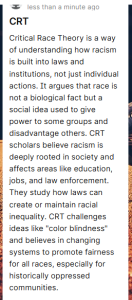3
Section One: The Fundamentals
A) Keywords
Exercise 1:
Briefly (in 100 words or less) define one of the keywords in the padlet (including one that you. may have added yourself).
|
|
B) Representing Race
Exercise 2: Notebook Prompt
In about 50-70 words, consider Joel Bervell’s question: why do we feel the need to extrapolate the athleticism of one Black athlete to all Black people when we do not do the same for white athletes?
Try to think of examples when this happens, making sure to reflect on your own positionality.
| I believe this has to do a lot with media, they often create this preassumption that black is more athletic and try to act like it is a praise when it is not. Like when it is a white athlete, they will often not get tired of mentioning hardwork and dedication, but whenever it is black athletes, more focus is put on being “inherently athletic”. I apologise that I fell into this trick myself, I saw media narratives that linked the success of Black athletes, such as Usain Bolt, to genetics, but after learning this bias it has opened my eye to the fact that how media has overlooked the dedication aspect of Black athletes.
|
C) Gender, Race & Sport
Exercise 3: Notebook Prompt
What are some strategies for resistance that Rajack and Joseph identify in their article as a means of pushing back against and resisting misogynoir?
| Some strategies for resistance they talk about is, Self-representation on social media (Razack & Joseph, 2020, p. 293). For example, Naomi Osaka shares her dual identities as Japanese and Haitian on social media sites like Instagram and Twitter. She fights media narratives that attempt to erase her Black identity by doing this. Using comedy to address racism is another strategy. Osaka responded to Japanese comedians’ mockery of her skin tone by promoting her sunscreen sponsor, demonstrating her ability to steer the racist remark. Collective action also comes into play. Fans and campaigners spoke up against media outlets’ misrepresentations of Osaka, which compelled them to issue an apology. These acts demonstrate how media can counteract sexist and racist narratives in sports.
Razack, S., & Joseph, J. (2021). Misogynoir in women’s sport media: Race, nation, and diaspora in the representation of Naomi Osaka. Media, Culture & Society, 43(2), 291–308. https://doi.org/10.1177/0163443720960919
|
Section Two: Making Connections
A) Athlete Activism
Exercise 3: Padlet Prompt
Do athletes have a responsibility to use their platform for social change? Why or why not? Please remember to record your response in both the padlet below and in your Notebook.
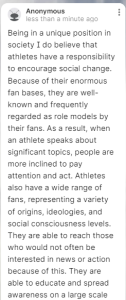 Being in a unique position in society I do believe that athletes have a responsibility to encourage social change. Because of their enormous fan bases, they are well-known and frequently regarded as role models by their fans. As a result, when an athlete speaks about significant topics, people are more inclined to pay attention and act. Athletes also have a wide range of fans, representing a variety of origins, ideologies, and social consciousness levels. They are able to reach those who would not often be interested in news or action because of this. They are able to educate and spread awareness on a large scale by leveraging their platform. Culture often is shaped by sports, and culture in turn shapes society ideals. Athletes have the power to spark talks that result in real change. While being silence on significant concerns could hinder progress, speaking up can give movements advocating for a more equitable and just society more traction. One example is Colin Kaepernick, who kneeled during the national anthem to protest racial injustice. His actions sparked nationwide discussions and inspired other athletes to speak out, proving how sports can drive social change.
Being in a unique position in society I do believe that athletes have a responsibility to encourage social change. Because of their enormous fan bases, they are well-known and frequently regarded as role models by their fans. As a result, when an athlete speaks about significant topics, people are more inclined to pay attention and act. Athletes also have a wide range of fans, representing a variety of origins, ideologies, and social consciousness levels. They are able to reach those who would not often be interested in news or action because of this. They are able to educate and spread awareness on a large scale by leveraging their platform. Culture often is shaped by sports, and culture in turn shapes society ideals. Athletes have the power to spark talks that result in real change. While being silence on significant concerns could hinder progress, speaking up can give movements advocating for a more equitable and just society more traction. One example is Colin Kaepernick, who kneeled during the national anthem to protest racial injustice. His actions sparked nationwide discussions and inspired other athletes to speak out, proving how sports can drive social change.
B) Athlete Activism & Feminism
Exercise 4: Complete the activities
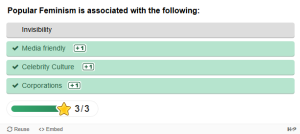
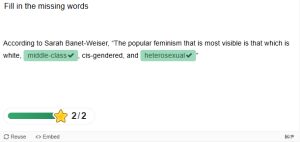
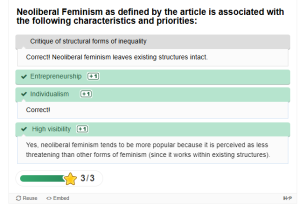
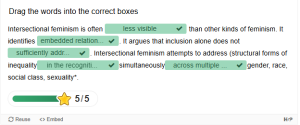
Exercise 5: Notebook Prompt
What do the authors of the article call for as a way of challenging how mainstream sports journalism privileges neoliberal feminist concerns? (100 words max.)
| The authors suggest that to challenge how mainstream sports journalism favors neoliberal feminism, it is important to tell stories differently. Instead of only focusing on content produced by traditional sports journalists, they argue for expanding what is considered “sports media” to include all media that covers sports, such as social media and independent platforms. This shift allows for a broader and more diverse representation of feminism in sports. They also emphasize the need to challenge existing power structures and dominant narratives that reinforce gender inequalities rather than simply advocating for inclusion within those systems
|
C) Corporate social justice
Exercise 6: Padlet Poll
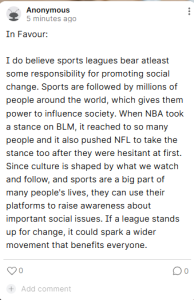 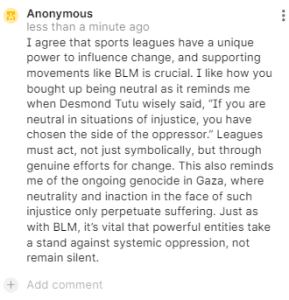
In Favour: I do believe sports leagues bear atleast some responsibility for promoting social change. Sports are followed by millions of people around the world, which gives them power to influence society. When NBA took a stance on BLM, it reached to so many people and it also pushed NFL to take the stance too after they were hesitant at first. Since culture is shaped by what we watch and follow, and sports are a big part of many people’s lives, they can use their platforms to raise awareness about important social issues. If a league stands up for change, it could spark a wider movement that benefits everyone.
Response : I agree that sports leagues have a unique power to influence change, and supporting movements like BLM is crucial. I like how you bought up being neutral as it reminds me when Desmond Tutu wisely said, “If you are neutral in situations of injustice, you have chosen the side of the oppressor.” Leagues must act, not just symbolically, but through genuine efforts for change. This also reminds me of the ongoing genocide in Gaza, where neutrality and inaction in the face of such injustice only perpetuate suffering. Just as with BLM, it’s vital that powerful entities take a stand against systemic oppression, not remain silent. |
Section Three: Taking a shot
Module Assignment (submit as part of notebook and separately through Blackboard mini assignment #1 portal)
Mini Assignment
Abdul Quiyum
0744564
KINE-3134H: Gender, Sport, & social Justice
Kelly McGuire
The television show I would like to analyze is Ted Lasso, as it is one of my favourite shows that brought tears to my eyes. The specific representation I am going to talk about is when Sam Obisanya takes a powerful stand against Dubai Air.
What strategies do athletes employ to speak out?
Athletes speak out in a variety of methods, frequently using their status as icons to speak out against injustice. Sam, a Nigerian football player for AFC Richmond, covers the logo of Dubai Air with a black tape on his shirt in protest of the airline’s affiliation with an environmentally damaging oil corporation. By utilizing his position to voice his beliefs and criticize business malpractice, he is engaging in a direct and visible act of self-representation. His quiet yet impactful demonstration is consistent with past athlete activist efforts, such Naomi Osaka’s use of social media to declare her identity and promote social justice (Razack & Joseph, 2020, p. 293).platform.
Fans and the media have no choice but to notice and interact with the message, which is why this tactic works so well. Sam’s demonstration reminds us of actual incidents, such as when Lebron James wore a shirt that read “I Can’t Breathe” in protest of police abuse. These messages are further amplified by social media, which enables sportsmen to communicate directly with the public and get over the boundaries of traditional media (Galily, 2019). By doing this, youngsters take charge of their stories instead of allowing businesses or sports leagues to shape them.
Sam’s protest also goes against the corporate sponsorship model in sports, which often prioritizes financial gain ahead of ethical concerns. His behavior implies that athletes are moral beings with the ability to affect public opinion in addition to being entertainment. His colleagues’ reaction, showing solidarity with him, demonstrates the effectiveness of group action, a crucial tactic in athlete activism.
In the end, athletes use social media, visual symbolism, and group action to get their message out there. Through public remarks, social media posts, or altered jerseys, these tactics raise awareness and challenge established power dynamics, reaffirming that sports are not only about competition but also about platforms for change.
What is the commentary on athletes using their voices in these shows?
The Dubai Air scene in Ted Lasso demonstrates how athletes can speak up for what is right. Because the company has negatively impacted the environment in his home country Nigeria, football player Sam Obisanya refuses to wear the trademark of the company. This instance demonstrates that athletes have the ability to speak up and change the world, proving they are more than simply athletes. The program makes it very evident that issues of politics, justice, and fairness in the real world are not isolated from athletics.
The show Ted Lasso makes it clear that using one’s platform is the right thing to do, and it shows that when athletes speak out, they offer a strong alternative message that challenges big corporations and the narrow views of traditional media.
As read in Shut Up and Dribble, this concept relates to actual athletes like Lebron James when he wears the t-shirt “ I can’t Breathe” (Galily, 2019). Many athletes, Black athletes in particular are advised to keep quiet about social issues. However, Lebron and others have fought for their beliefs using their popularity. In a similar way, Naomi Osaka has encountered difficulties due to her identity and race. According to Razack and Joseph (2020), she has embraced her Japanese and Haitian ancestry and used her position to support movements such as Black Lives Matter.
The power of teamwork is also highlighted throughout the show. Sam’s colleagues stick by him when he speaks up, demonstrating that solidarity makes activism stronger. The message they are trying to portray is very clear that athletes should not just put their head downs and just play. They are entitled to raise awareness of significant issues by using their voices. They should not be suppressed to speak against the injustice. By doing this, they help to change the perception of sports so that they are seen as justice and fairness as well as competition (Galily, 2019) (Razack & Joseph, 2020).
How do race and/or gender or other *identities inform this representation?
As we talked about earlier, Ted Lasso uses Sam Obisanya’s protest to illustrate how race and identity influence an athlete’s representation. Sam, a Black football player from Nigeria, speaks out against a company sponsor that is hurting his nation. His identification gives his protest greater significance since it relates to his upbringing and individual experiences. The show shows how racialized athletes’ activism is frequently closely linked to their histories and communities, which strengthens their voices when they speak out.
The idea is similar to what we observe in actual athletes such as Naomi Osaka. The media frequently highlights Osaka’s Japanese ancestry while neglecting her Haitian background, as Razack and Joseph (2020) clarify. This demonstrates how an athlete’s race can influence how others think of them. Osaka’s support of Black Lives Matter drew both praise and criticism, highlighting the difficulties colored athletes face when they speak out.
Lebron James’ support has also drawn criticism. Galily (2019) explores in Shut Up and Dribble how James takes advantage of his celebrity to speak out against racial injustice, yet his critics have advised him to be quiet and concentrate solely on basketball. This trend demonstrates how race affects which voices are accepted in sports, with Black sportsmen expected to entertain rather than take part in activism.
Sam’s demonstration in Ted Lasso challenges these ideas by demonstrating that athletes should not have to keep their activism and identity separate. His colleagues’ support for him serves as a reminder that identity and race are significant in athletics and that speaking up may actually lead to change.
How do these representations shape how we understand the sports themselves?
The way athletes are shown in Ted Lasso and real-life changes how we see sports. It is clear from Sam Obisanya’s protest in the show that sports provide a platform for speaking out about issues in the real world in addition to being a way to play a game. His deeds demonstrate that athletes are more than simply entertainers; they are also individuals with morals, obligations, and the ability to confront injustice.
Again, bringing up Lebron James and Naomi Osaka, Lebron’s political activism and Osaka’s struggle for racial fairness demonstrate the connection between politics and sports. Our views of athletes like Osaka can be influenced by the way they are shown in the media. Lebron’s experience demonstrates that sports can be spaces for transformation in addition to being about playing games.
Because they show that sports are about more than just competition, these situations change our view of sports. They serve as platforms for athletes to advocate for justice, speak out, and motivate others to change the world. As seen by Sam’s experience in Ted Lasso, sports activism has genuine significance in both real-life and fictional contexts. This raises the question of whether large corporations or the athletes themselves are in charge of sports. Sports are ultimately about bringing about change, not just about winning.
References:
Razack, S., & Joseph, J. (2021). Misogynoir in women’s sport media: Race, nation, and diaspora in the representation of Naomi Osaka. Media, Culture & Society, 43(2), 291–308. https://doi.org/10.1177/0163443720960919
Galily, Y. (2019). “Shut up and dribble!”? Athletes’ activism in the age of Twittersphere: The case of LeBron James. Technology in Society, 58, 101109. https://doi.org/10.1016/j.techsoc.2019.01.002

